SEO marketing campaigns should start with keyword research, specifically competitor keyword research. This is a non-negotiable.
If you’re not doing keyword research and competitor analysis right, that could cost you (or your clients) a lot of wasted cash.
In this article, let’s talk about why keyword competitor research is so important, how to find your competitor keywords, and how to make your keyword research effective as a whole.
Why is Finding Competitor Keywords So Important?
The importance of finding competitor keywords in SEO cannot be understated. Competitor keywords are the search queries that your competitors are currently targeting to improve their SEO ranking and generate more traffic online.
The first step to doing competitor keyword analysis is to find out which keywords are working well for your competitors so far. This sneak-peak allows you to optimize your website based on those keywords.
Checking competition keywords allows you to:
- Find competitor keywords that can improve your site’s SEO.
- Have a better insight into the competitive landscape and find potential market gaps you can fill
- Understand which keywords your competitors are ranking for and why
- Learn more about how Google or search engines work and how they rank and prioritize results
- Understand user intent and which keywords your target audience is using to meet their needs
How to Find and Analyze Competitor Keywords
Simply put, keyword competition analysis is the process of figuring out what you should be trying to rank for.
Follow the steps below to effectively perform competitive keyword analysis and find the right competitor keywords to target:
Step 1: Find your competitors
You most likely already know who your market competitors are– the companies, whether local or global, that are offering the same products/services as you. However, in the SEO game, your competitors can go even broader.
For example, if you’re selling furniture, you’re not only competing with other furniture dealers or manufacturers in the SERPs but also with Interior Design e-magazines, real estate websites, or furniture repair and upholstery services.
You need to know your SERP competitors that are ranking for the same core key terms you’re targeting.
They may be ranking for certain keywords you’ve never considered before, and that’s a great way to tap that keyword and content opportunity that can attract the right audience to your site.
Come up with a list of a few search engine and market competitors to begin your keyword research and competitor analysis.
Step 2. Do a Competitor Gap Analysis
You can easily do a Competitor Gap Analysis with Keywords Everywhere. Let’s stick to the furniture business example. If you’re looking for direct competitors doing or selling the same thing/s as you, you can search on Google keywords like:
- home furniture and decor
- home furniture
- home decor products
- home decor products
- home decor accessories
Take note of at least the top 5 direct competitors ranking for such keywords.
If you try to target other more specific search terms, you notice how your range of competition becomes more extensive.
For example, if you want to target an informational keyword “bedroom decor ideas”, the first page of Google will be filled with websites that are not necessarily your direct competitors. They’re either e-magazines, affiliate websites, or UGC platforms like Pinterest.
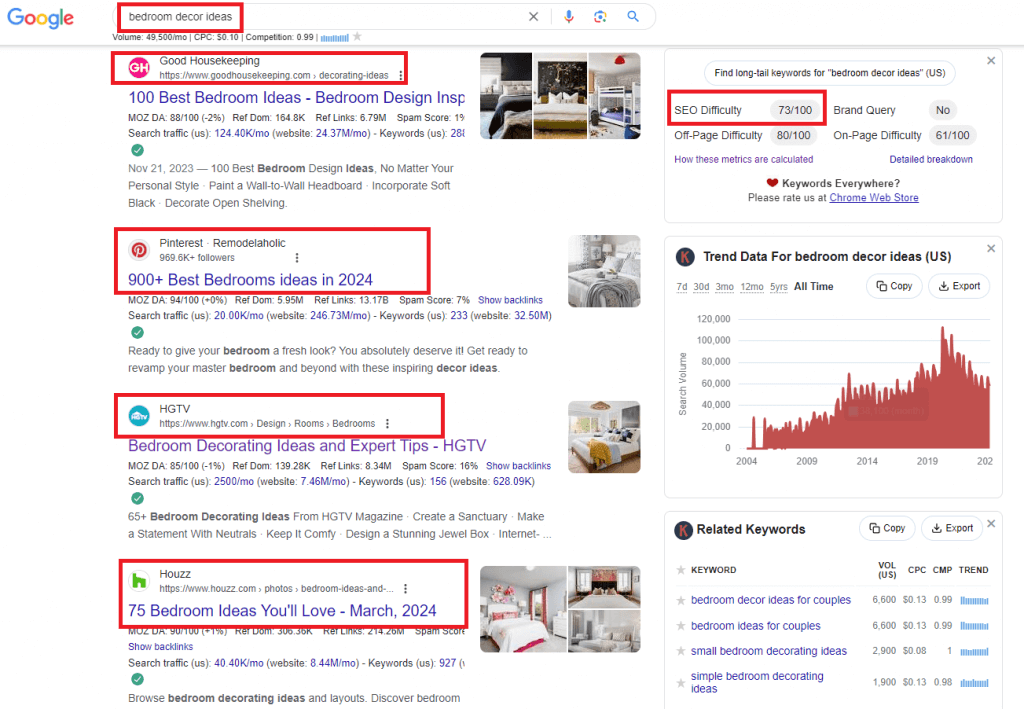
Using the Keywords Everywhere, you can readily see crucial SEO insights per website from Moz including the domain authority, Spam Score, and all of the backlinks each URL has earned.

And if you move your mouse over, large pop-ups will appear showing other important SEO insights like:
- Organic traffic that URL is getting per month
- Other keywords that URL is ranking for
- Organic Traffic that domain is generating per month
- And the total number of keywords the domain ranks for
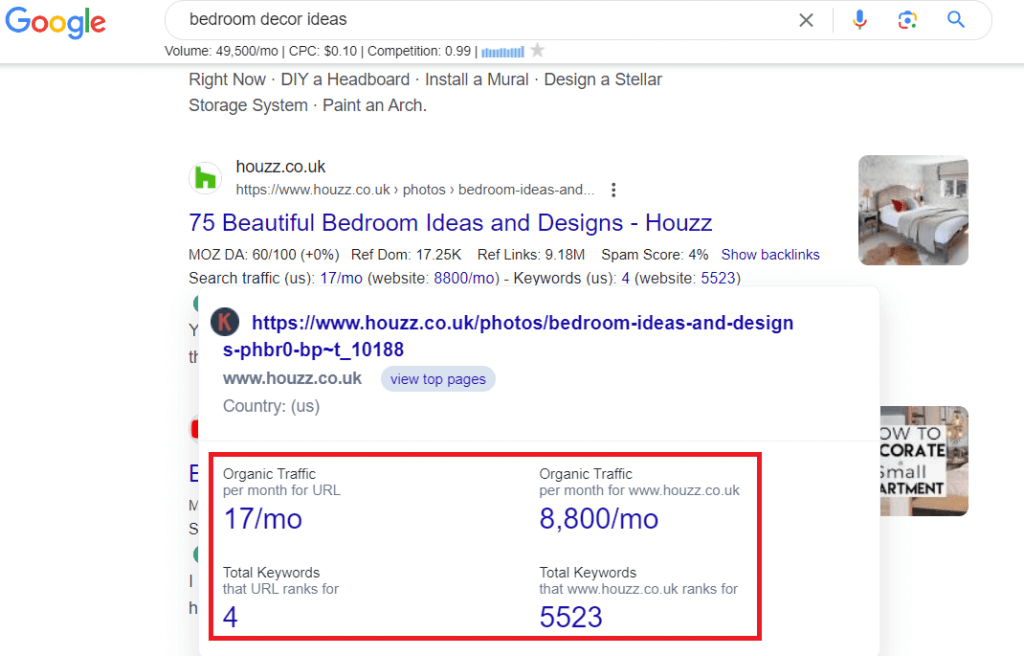
Having this information is crucial to check how strong the competition is and find the keywords your competitors are using to rank.
If you click those blue stats, you’ll be redirected to more extensive results to further research competitor keywords.
Straight off the bat, using the Keywords Everywhere, you can see that the keyword ‘bedroom decor ideas’ has a search volume of 49,500 per month. However, its SEO difficulty is 73/100.

In general, you want to target keywords with low to medium difficulty. Refer to the guide below:
- Low Difficulty Keywords (0-30)
- Lower search volume but easier to rank for
- Best for targeting long-tail keywords
- Perfect for new websites
- Medium Difficulty Keywords (31-60)
- Moderately competitive keywords
- If you’re already an established site, you can target these keywords
- Great balance between search volume and competition
- High Difficulty Keywords (61-100)
- The most competitive keywords
- These very competitive keywords are dominated by high authority sites with well-established online presence
- Takes time and resources to outrank these results
Finding and targeting the right competitor keywords can dictate whether or not you can successfully rank your content.
To find more competitor keywords with the right balance of search volume and SEO difficulty, you can click “Find long-tail keywords for bedroom decor ideas” as highlighted in the image above.
Finding Competitor Keywords Using Keywords Everywhere
When you open the Keywords Everywhere Extension, you’ll see the key features you can use for SEO competitor analysis as highlighted below.
We’ll explore these three features and how to check competitor keywords in detail.
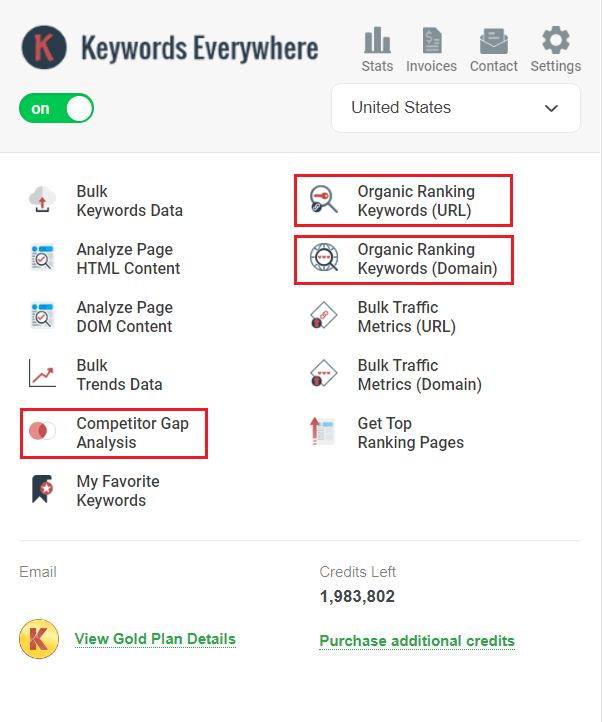
1. Organic Ranking Keywords (URL)
To find competitors keywords thoroughly, you can open the links to the first 5-10 results pages on Google or other search engines.
Taking the same keyword example ‘bedroom decor ideas’, some of the results lead to UGC platforms like Pinterest and Houzz while some are actual blog articles with in-depth coverage of the topic.
Open the links with high-quality content and do further keyword competitor analysis using Keywords Everywhere by simply clicking “Organic Ranking Keywords (URL).

You’ll be shown a full list of the top 5000 keywords that specific URL is ranking for and the corresponding estimated traffic, SERP competitor ranking position, and other crucial SEO insights.
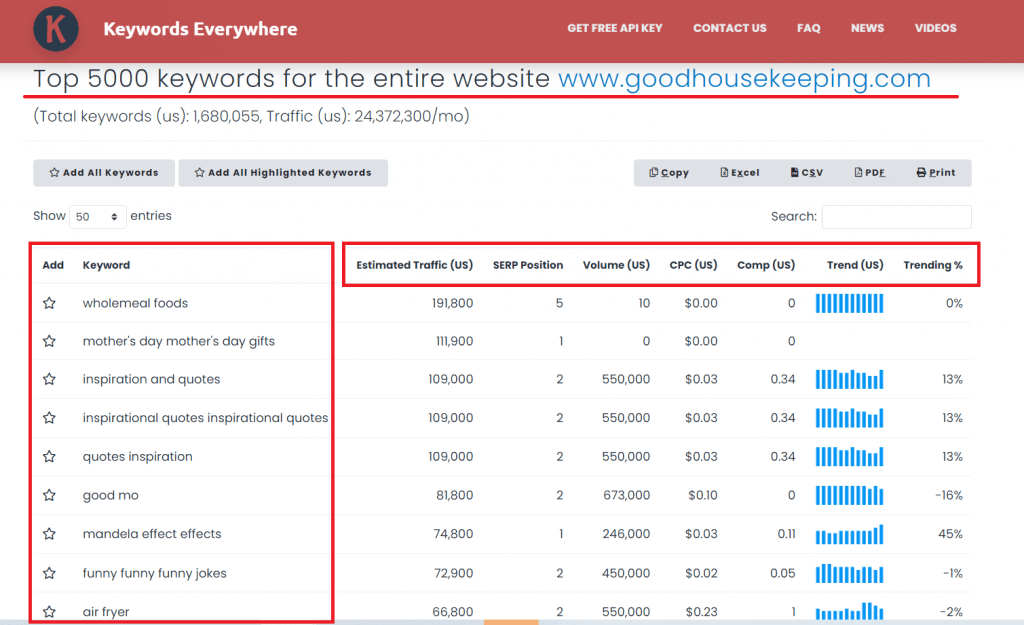
2. Organic Ranking Keywords (Domain)
If you click “Organic Ranking Keywords (Domain)”, you can see all of the keywords the entire domain is ranking for and the estimated traffic each keyword brings to the site.
You can also see the SERP position for each organic keyword, the CPC, trends, etc. This is a fast and easy way to find competitor analysis keywords and other possible topics you can touch on.
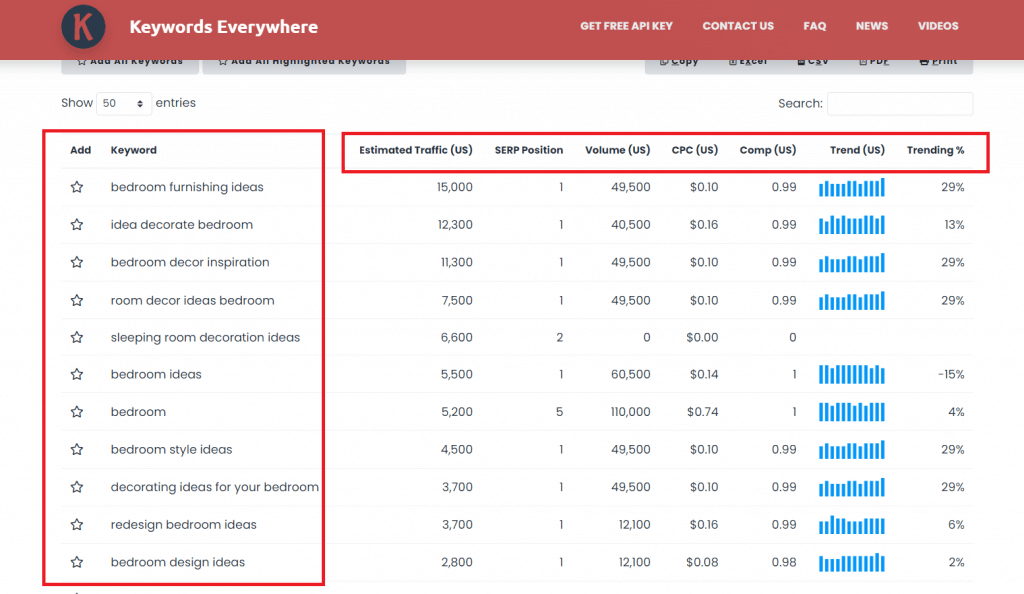
Using Keywords Everywhere, you can easily find keywords used by competitors.
Note: After you scan the URL and Domain for keywords, make sure you copy or download the Excel, CSV, or PDF files, so you won’t have to scan again and use up credits.
You don’t necessarily have to use all of the keywords you find. The point of keyword competition research is to just discover other relevant keywords that match the user intent you want to capture and to analyze how you can outperform SERP rivals.
If a keyword is too competitive, analyze and decide whether or not to pursue such a term or just focus on a niche or long-tail keyword to improve your chances of ranking.
3. Competitor Gap Analysis
The last Keywords Everywhere feature we’re going to highlight is probably the most important one and the easiest way to find valuable competitor keywords.
This feature enables you to find all keywords your competitors are ranking for that you are not.
You’ll see which keywords are driving the most traffic to their websites, so you can know what topics or keywords you should be writing about or targeting to better compete in search engine ranking.
All you have to do is follow the steps below:
- Click on the Keywords Everywhere extension and click on “Competitor Gap Analysis”.
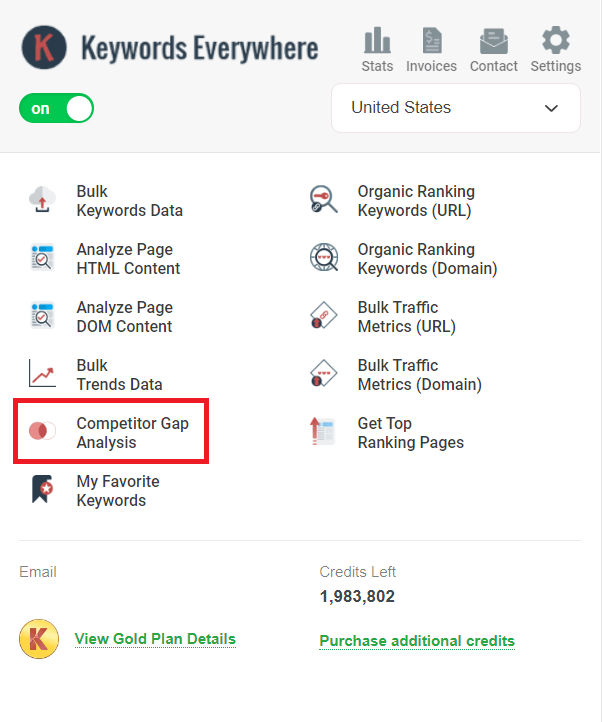
2. You’ll then be redirected to the page below where you can enter your website. Keywords Everywhere will show a dropdown of the relevant domains and subdomains. Choose the correct one. You can either choose the one with www. or the non-wwww.
If Keywords Everywhere does not show your exact domain, that means we don’t have data around that domain yet.
We scrape Google for the top 230 million keywords (based on volume), and websites found in the top 30 positions of these keywords are added to our database. New websites or those that don’t rank for any of those 230 million keywords in the top 30 positions will not be added to our database.
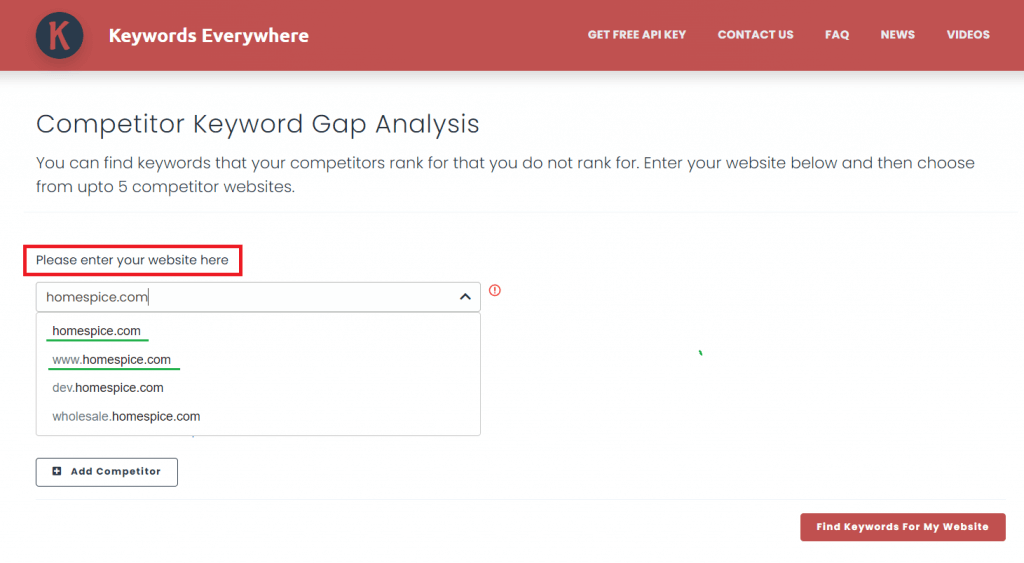
3. Enter up to 5 competitor domains then click “Find Keywords for My Website”.
When choosing a competitor domain from the dropdown, you can also choose the blog subdomain of the competitor if you’re looking to capture more competitor keywords for blog purposes (like in the second competitor website below).
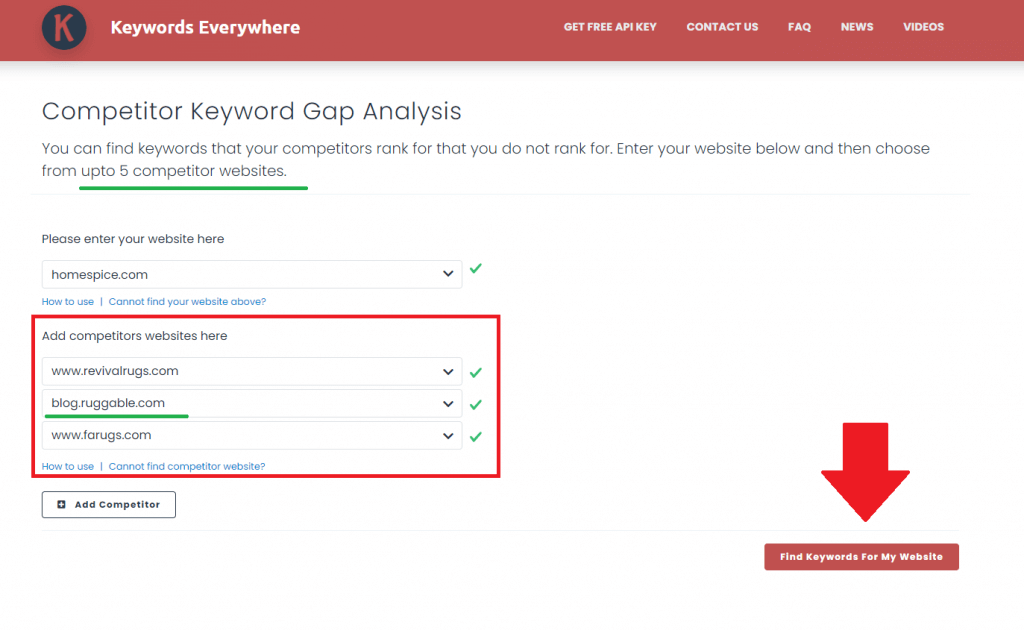
4. Our tool will instantly display all the keywords your target competitors are ranking for that you are not:

The red box above shows you the amount of traffic each keyword generates for each competitor website per month. The figures inside the parentheses are the competitors’ corresponding SERP position for each keyword.
The main SEO data per keyword including Volume, CPC, Competition, Trend, and Trending Percentage will still be shown.
5. You can further scroll down that page to check the full list of keywords your competitors are using to rank on Google.
As you do so, you can begin scanning or analyzing potential keywords you can target for your own website.
For example, for the sample website homespice.com which mainly sells braided rugs, we can look out for keywords that are relevant to the product/s in question.
You can easily do this by clicking the star icon next to your desired keyword. Your starred keywords will be saved to your My Favorite Keywords list that you can later copy or download.
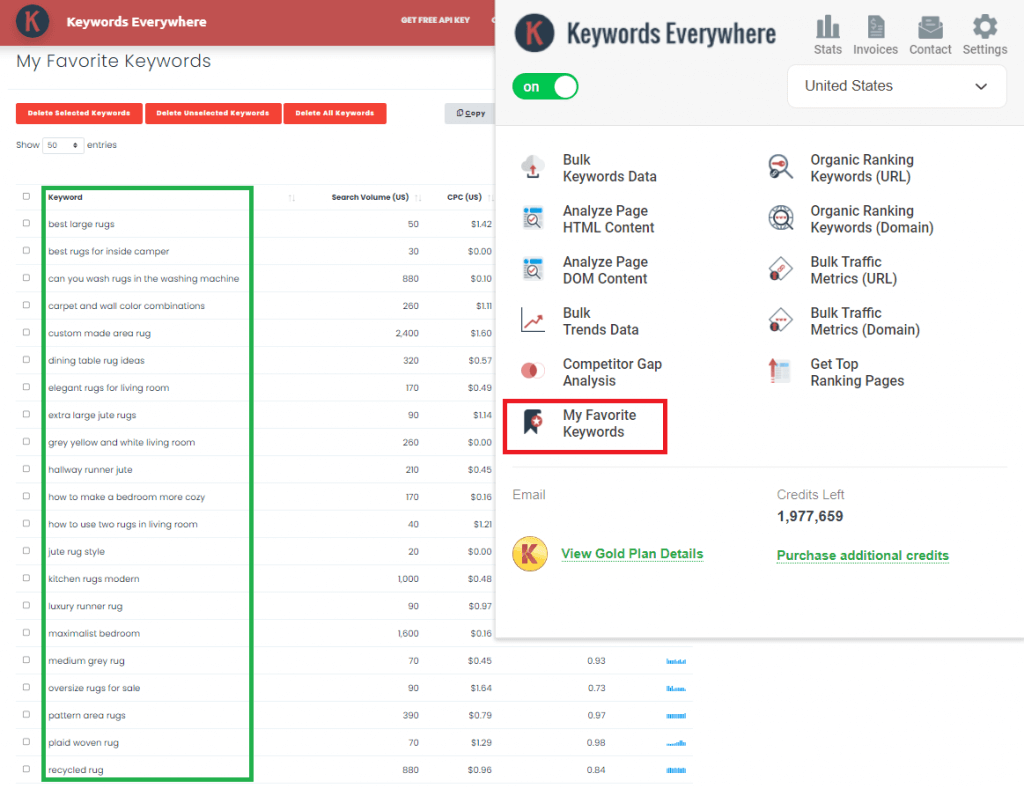
You can also click “Copy” and paste the full results onto a spreadsheet to filter data more easily. You may also download the Excel, CSV, or PDF file or print the results.
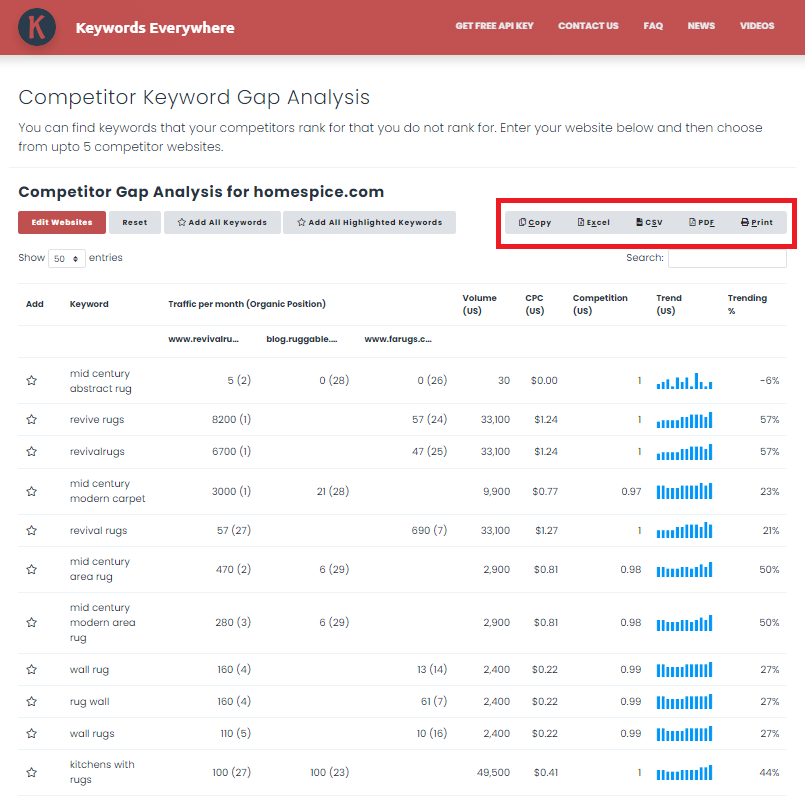
You can sort keywords through a spreadsheet and arrange the desired information in descending or ascending order.
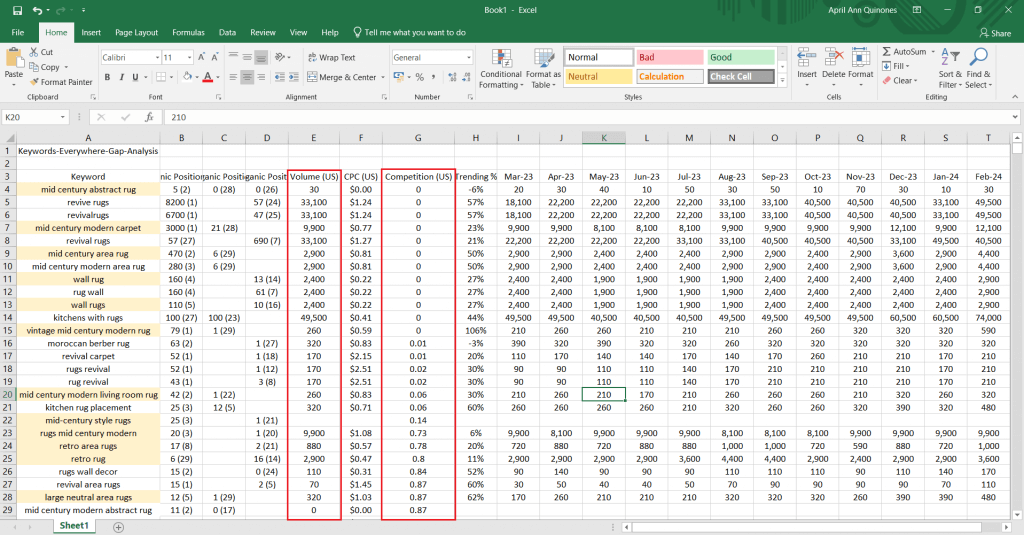
In the example above, the Competition score is set to descending, so you can easily find and track the keywords with low PPC competition and highlight the relevant ones with decent search volume. The competition score is set from 0-1, with one being the most difficult.
If you want to arrange the data based on Search Volume, you can also set the filters accordingly depending on your goals and SEO strategy.
When targetting keywords based on search volume, do further keyword research using Keywords Everywhere to check the actual SEO difficulty of each selected keyword.
Don’t forget to check the other factors like CPC and Trend. The last 12 columns on the sheet are the trends over the past 12 months.
The trending percentage allows you to check if the keyword is generating more search volume or less. That way, you can verify if it’s an evergreen or seasonal keyword or if the keyword is still relevant or not.
Now that you’ve found competitor keywords you can target, it’s time to further refine your list by focusing on the next step:
Step 3. Focus on Search Intent
When deciding which competitor keywords to target, focus more on Search Intent instead of Search Volume. Don’t get me wrong; search volume does matter. After all, how would people ever find your content if there’s little to no search volume?
The point is to not choose keywords just because of their search volume. Never forget to factor in the search intent as well, the ‘why’.
As you review the competitor keywords you’ve narrowed down, focus on the reason ‘‘why someone is searching’.
For a furniture company that is looking to generate sales, the following are sample keywords that might NOT readily lead to sales:
- how to choose paint color
- bedroom floor plan
- how to clean mattress
If you want keywords that can possibly lead to purchases, you can go for something like:
- best furniture for small bedroom
- aesthetic bedroom ideas
- Master bedroom furniture list
- multi functional furniture for small spaces
Remember the 4 types of search intent and hone in on the keywords that can capture awareness, interest, desire, and action.
If a user is looking to learn about something, help them do just that by creating the best content for that search term.
If a buyer is ready to buy, make sure to add those buyer intent keywords to your product or service pages because the user will then be ready and happy to make a purchase.
Check keyword competition for all types of intent and optimize accordingly.
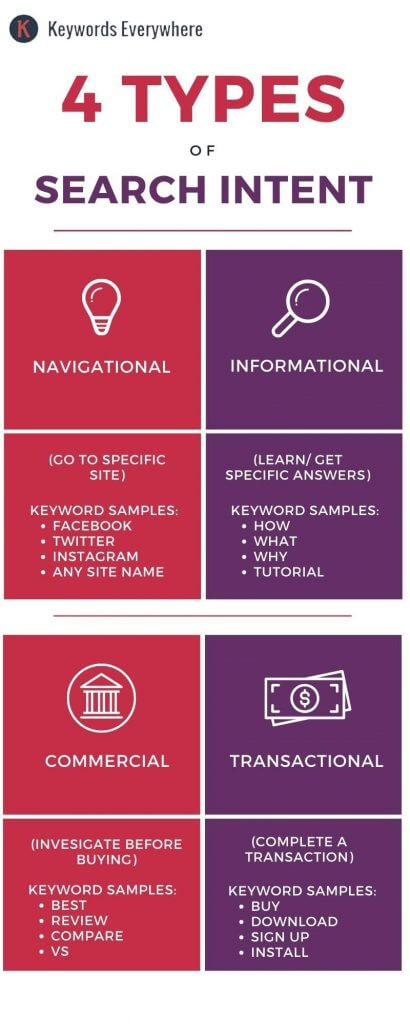
Search Intent Examples
For a furniture company selling home furniture and accessories, your target customers are those who want to beautify, furnish, or renovate their homes.
Your target audience could have different search intent. You don’t need to target one specific search intent for the entire course of your content marketing campaign.
In fact, you can try to target all types of keyword intent. For example:
1. Informational search intent example:
Your target user could still be in the ‘learning stage’ and are entering keywords with informational intent for now. Let’s call her Sarah.
Sarah wants to renovate her dull and boring bedroom. At this point, she doesn’t really know how or where to start, so she could be typing in some broader terms like:
- Bedroom ideas
- Beautiful bedroom ideas
- Small bedroom ideas
- Best interior design for bedroom
- Bedroom design inspo
How to target this informational intent:
You could provide Sarah with a lot of value by helping her decide which bedroom ideas are perfect for her style and her needs.
As you go about it, you can provide examples of images and ideas featuring your own home furniture and decor products!
Although Sarah wasn’t actively looking to buy, your valuable content has the power to help her make an informed decision– all in your favor.
2. Commercial search intent example:
Sarah may already have an idea of what types of furniture, appliances, or decor she likes, so she could be searching more specific terms like:
- Best Japandi style bed
- Stylish humidifier for bedroom
- Linen vs cotton sheets
- Best linen sheets
At this time, the user is already in the market for certain products but is just doing further research to identify the specific product or brand to go for.
Other common keywords related to commercial search intent are “top”, “reviews’, ‘best’, or ‘compare’.
How to target this commercial intent:
If you’re not selling humidifiers, there’s no point in targeting or prioritizing competitor keywords like ‘bedroom humidifiers’.
Be as intentional as possible by looking for commercial keywords that are relevant to your products and services.
For example, you can do a roundup post featuring the best products you offer. If you’re running an Amazon affiliate site featuring home decor, you have virtually unlimited product options you can include.
3. Transactional search intent example:
If the user has already decided to buy something or perform any specific action, they’ll use buyer intent keywords like:
- buy mattress online
- bedsheet for sale
- discount bedroom furniture sets
- home decor and furnishing coupons
- Custom bedroom furniture quote
How to target this transactional intent:
You can also use local transactional keywords as users may enter something like “affordable mattress canada” or target long-tail transactional keywords like “cheap bedroom sets with mattress included”.
4. Navigational search intent example:
When users do a navigational search, they already have a brand or company in mind, and if you aren’t the brand or product they’re looking for, it’s going to be difficult to outrank the results for such keywords.
For example, if the user enters ‘ikea furniture’, it’s likely that the first page of Google will be filled with web pages of the official Ikea website or sites that distribute Ikea products.
You can try targeting competitor keywords like ‘Ikea furniture alternatives’, but you also need to pay attention to search volume when doing keyword research competitor analysis.

As you can see, the keyword above has 10 monthly searches and an SEO difficulty of 57/100. You want that sweet spot of higher search volume and lower competition.
Using Keywords Everywhere, you can easily see related keywords and their corresponding search volume, CPC, competition score, trends, long-tail keywords, and more.

Overall, when it comes to search intent, just make sure to refer to the marketing funnel below. The closer you are to the bottom of the funnel, the more likely customers are to buy or convert.
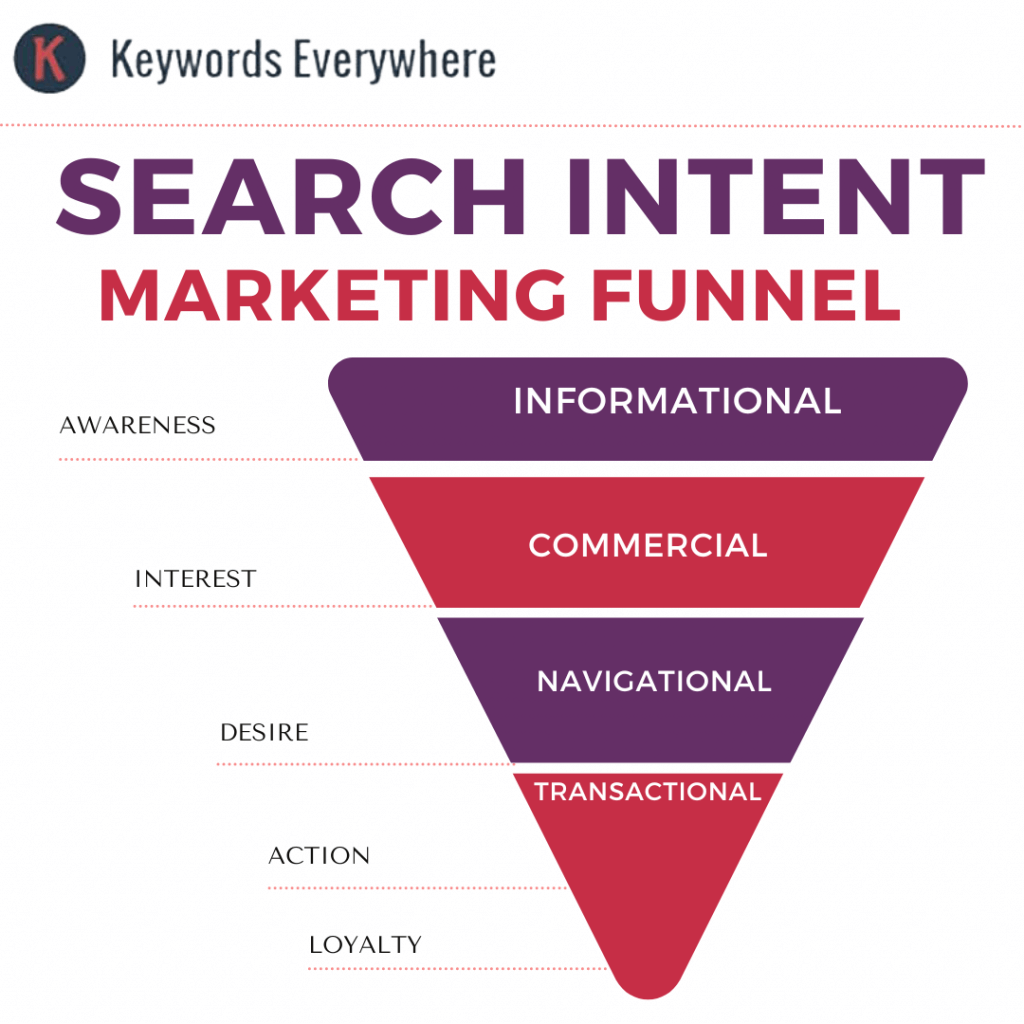
- If you want to build awareness and authority, you can target more informational keywords competitors are using to educate readers effectively.
- If you want to help readers learn more before completing an action, you can use commercial keywords.
- To prompt users to complete an action, tap some transactional keywords, especially in your product or service pages.
- If your brand becomes more established over time, you’ll naturally attract navigational searches.
The search intent you should be targeting should depend on your company’s needs and budget. If your SEO budget is limited and you need to drive ROI asap, you may want to research competitor keywords and choose the topics that are closer to sales conversion.
For example, if you have an Amazon affiliate page that sells kitchen gadgets and utensils, it’s better to prioritize a competitor keyword like ‘how to choose a smart blender’ or ‘vitamix vs Blendtec Review’ than something like ‘how to clean your Vitamix Blender”.
People who search for ‘how to clean’ keywords are no longer in the buying stage, so it’s best to focus on competitor keywords with a stronger buying intent if you’re looking to prioritize sales.
In the end, there’s no point in ranking #1 on SERPs if it actually doesn’t lead to sales or conversion. Be strategic, and add value while also actively targeting keywords that can make your readers closer to your brand and what you’re offering.
Avoid high-volume terms that are highly competitive. It’s hard to stand out when you go after the same key terms as everyone else. Don’t forget about the mid-volume keywords that match search intent. They’re easier to rank for and also cheaper to bid on.
Common Keyword Research Mistakes
If you’re an SEO, make sure you’re not making the following common keyword research mistakes:
1. Not targeting multiple keywords per page
You don’t have to use one keyword again and again to help Google understand the point of the content. Using Keywords Everywhere, you can see that the results on the first page of Google are also ranking for many other relevant keywords.
Use Keywords Everywhere to find competitor keywords and make sure to match up similar keywords with different phrase variations. Check the Related Keywords, People Ask for widget, and Long-tail Keywords section.
For example, if you want to cover ‘aesthetic bedroom ideas’, instead of using that search term again and again, you can check Keywords Everywhere’s Long-tail Keywords widget and use other relevant terms for your subheadings:

That will not only help you cover and rank for other descriptive variations, but they’ll also help you enrich the user experience and make your article more thorough.
Choose those related terms and check competitor keywords that have decent search volume and low organic search competition.
2. Ignoring Keyword Difficulty
If your website already has a high enough Domain Authority, you may want to have a go at competitor keywords with higher SEO difficulty.
However, if you haven’t established your search engine ranking score yet, never ignore the SEO difficulty metric.
As a rule of thumb, check the guide below to gauge the keyword difficulty of the competitor keywords you find. You want a higher search volume with lower organic search competition. That’s the sweet spot.
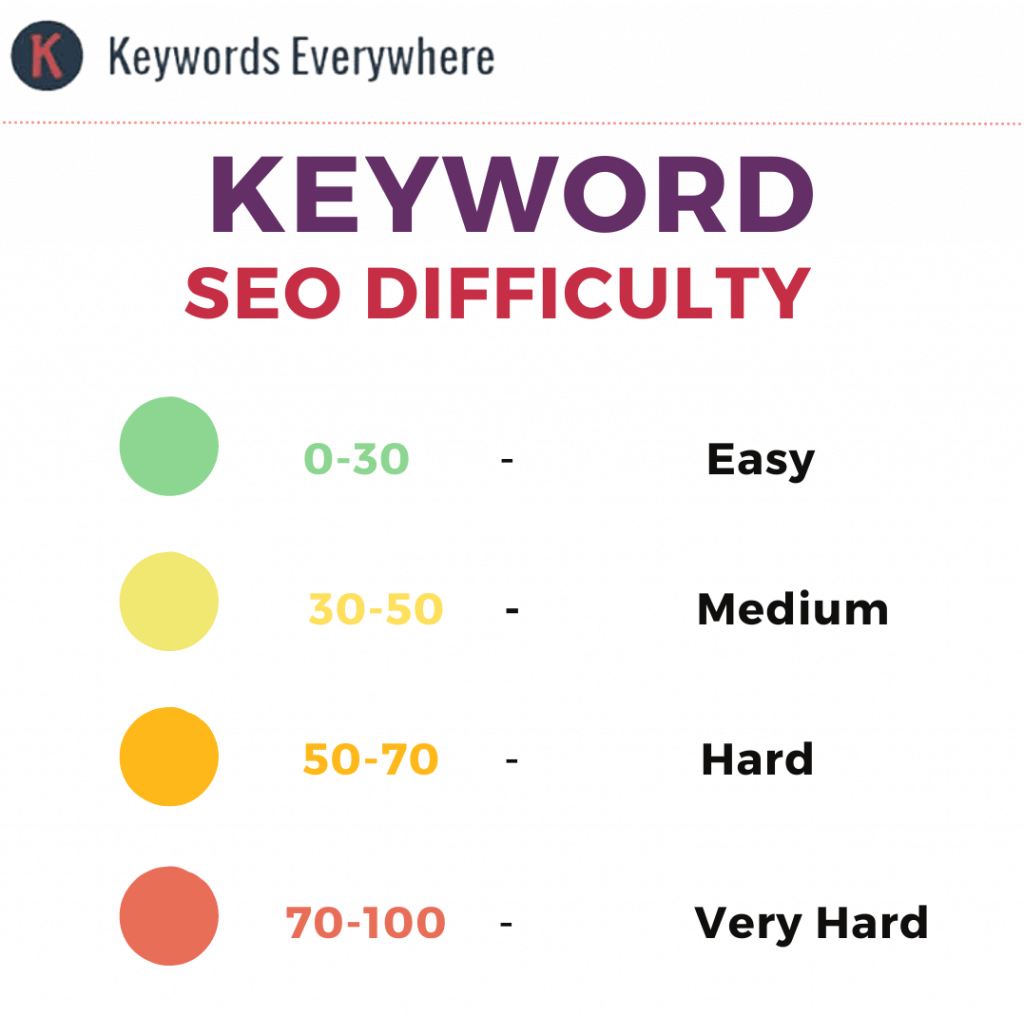
3. Letting the clients choose the keywords
If you’re hired as the SEO expert, you need to guide clients when they want to pursue competitor keywords that are either too broad or too difficult to rank for. Their goals and ideas are the starting point but not necessarily the endpoint.
Make sure that your competitor keyword list is actually based on data– and not just gut instinct.
4. Failing to study the SERPs
Again, don’t just rely on competitor keyword analysis tools. You need to study the quality and nature of the SERPs to properly analyze competitors keywords. Check what types of content Google is ranking for certain terms.
Find gaps, analyze competitor keywords, and use everything you see as valuable data to make your SEO decisions informed and intentional.
5. Focusing on one channel only
Remember that Google isn’t the only search engine. Every platform has its own algorithms and SEO insights.
The good thing about Keywords Everywhere keyword competition checker is you can use it for Google SERP and 19+ other platforms including YouTube, Bing, Amazon, eBay, Etsy, and more.
6. Not paying attention to localization
People from different countries search for the same keywords differently. If you have a target region, you need to pay attention to that.
Using Keywords Everywhere, you can open the extension and set your target region using the dropdown below.
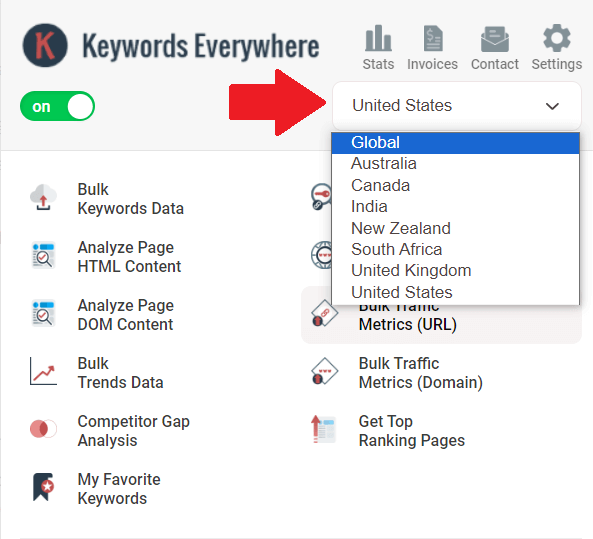
7. Not optimizing existing content
Competitor keyword research is not only for finding competitor keywords and creating new content. You can also make the most of it to test competitor keywords for your existing content. You can optimize existing articles by:
- Adding a whole new section with the new competitor keywords you discovered
- Rewording your meta descriptions
- Rewording your H structures
- Enhancing overall readability and scannability
- Doing image optimization
- Adding FAQs
- Adding videos or infographics
Now that you know how to find competitor keywords, you can now make your SEO efforts more strategic and fruitful.
Just make it a habit to always check competitor keywords before you start developing your content. Find out what keywords competitors are using and deliver something even better!
Conclusion
Doing competitor keyword research and SEO right can and shall pay huge dividends. The organic traffic you can generate from the SERP can outperform paid traffic or ads and produce leads for years to come.
However, do remember that keyword competitor research only serves as the foundation of your SEO strategy. To actually make it to the top, ensure that every article, blog post, and product description you post is more readable, valuable, and complete than your competition’s.
Also, organic SEO is a long-term process. There are certain terms or phrases that you can rank for quickly, but most businesses climb up the SERPs gradually.
The goal is to help Google make their searchers satisfied– meeting their needs, whether that’s accessing the right information, buying the right product, or completing the right transaction online.
As long as you commit to that, expect good news and good rankings in due time.


